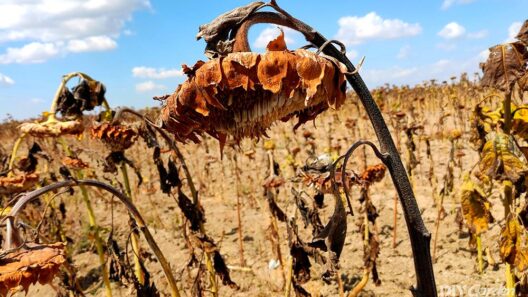As the global community grapples with the impending ramifications of climate change, the quest for alternative fuel sources remains paramount. Among these, biofuels have emerged as a prominent contender. While they offer a promising pathway toward reducing greenhouse gas emissions and dependency on fossil fuels, the question looms: Are biofuels a viable solution or merely a smokescreen for deeper systemic issues? This exploration will encompass the various dimensions of biofuels, from their types and production methods to their environmental impact and socio-economic implications.
To understand the potential of biofuels, it is crucial to categorize them into first, second, and third generations, each with unique characteristics and applications. First-generation biofuels are derived from food crops, such as corn and sugarcane. For instance, ethanol is produced from fermenting sugars in these crops, while biodiesel is made from vegetable oils and animal fats. While this generation offers a straightforward approach to biofuel production, it raises significant concerns regarding food security and land use. The diversion of agricultural resources from food production to fuel can exacerbate hunger and inflate prices, especially in vulnerable regions.
Second-generation biofuels, or advanced biofuels, are derived from non-food biomass, such as agricultural waste, forestry residues, and dedicated energy crops. These feedstocks present a dual advantage; they do not compete with food crops and can utilize existing waste materials that would otherwise contribute to landfill mass. The production of cellulosic ethanol, for example, exemplifies the potential of second-generation biofuels to tap into lignocellulosic biomass. Nevertheless, the technological barriers related to the conversion of this feedstock into usable fuel remain formidable, often resulting in higher production costs.
Third-generation biofuels take the innovation further by sourcing energy from algae. These microorganisms can grow in diverse environments, require minimal arable land, and yield high amounts of oil. Algal biofuels are lauded for their potential to significantly reduce carbon emissions, as the algae consume carbon dioxide during photosynthesis, thus contributing to a closed-loop system. However, the current technological and economic challenges related to large-scale production are significant hurdles yet to be surmounted.
Transitioning from theoretical discussions to practical realities, we must consider the life cycle of biofuels, from production to consumption. Analyzing the life cycle emissions associated with biofuel production is essential in determining their true environmental benefits. For instance, while the combustion of biofuels releases fewer pollutants than fossil fuels, the cultivation phase—especially in the case of first-generation biofuels—can generate vast amounts of greenhouse gases through land-use change and fertilizer application. In contrast, understanding the entire life cycle can illuminate the true impact of biofuels. A life cycle assessment (LCA) serves as a critical methodological tool in this analysis, helping quantify greenhouse gas emissions and identifying opportunities for improvement.
Furthermore, the socio-economic implications of biofuel production raise critical ethical and sustainability concerns. Large-scale cultivation of bioenergy crops has the potential to displace local communities and traditional agricultural practices. The phenomenon of land grabbing, where foreign corporations acquire large tracts of land for biofuel production, can exacerbate social inequalities, leading to conflicts and resistance from local populations. Effective policymaking and regulatory frameworks are essential to safeguard the rights of these communities and to promote sustainable practices within the biofuel industry.
Advancements in technology, particularly in precision agriculture and enhanced biotechnological methods, could play a pivotal role in making biofuels more advantageous. By improving crop yields and reducing input requirements, technological advancements may alleviate some of the aforementioned concerns related to food security and sustainability. However, a cautious approach is warranted. Over-reliance on technology may obscure the underlying issues inherent to the current agricultural paradigms and could further entrench the very systems that contribute to environmental degradation.
This discussion brings us to a critical intersection of policy and practice. Governments and institutions must balance the promotion of biofuels with regulations that safeguard environmental integrity and community rights. Implementing incentives for sustainable practices—such as subsidies for second and third-generation biofuels—can accelerate positive development in the sector. Collaborative initiatives between governments, private sectors, and research institutions will also be instrumental in driving innovation and addressing the technical challenges facing biofuel production today.
Additionally, public perception plays a pivotal role in the adoption of biofuels. Education initiatives aimed at informing consumers about the nuances of biofuel production and its implications for climate change can foster a more informed populace. Empowering individuals with the knowledge to make conscious choices about energy consumption fosters a culture of sustainability. As consumers demand more transparency and accountability from their energy sources, the biofuel sector may be compelled to elevate its standards and practices.
In conclusion, biofuels present a complex yet compelling opportunity in the fight against global warming. Their potential to reduce emissions and enhance energy security cannot be overlooked. However, stakeholders must approach this industry with a critical eye, acknowledging the potential pitfalls while striving for innovation and ethical practices. Whether biofuels emerge as a groundbreaking solution or a mere smokescreen heavily relies on our collective ability to navigate the intertwined fabric of environmental impact, socio-economic challenges, and technological advancement. The future of biofuels, and indeed the fate of our global climate, hinges on the choices we make today and the policies we implement in the years to come.






